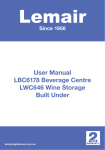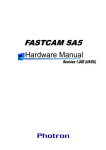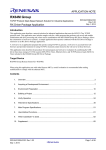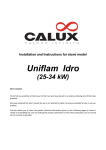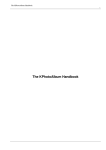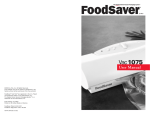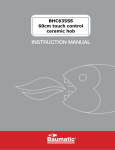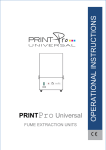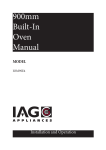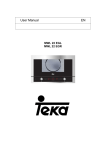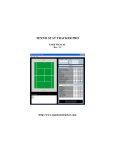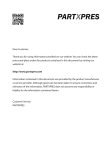Download User Manual EN
Transcript
User Manual EN 1730243-a BCG 22 EN Contents Safety Information .............................................................................................................................. 2 Safety Instructions ............................................................................................................................. 5 The advantages of microwaves ......................................................................................................... 6 Description of your oven.................................................................................................................... 7 Description of your oven.................................................................................................................... 8 Basic settings ..................................................................................................................................... 9 Basic Functions ................................................................................................................................ 10 Special functions .............................................................................................................................. 13 Using the Browning Plate ................................................................................................................ 15 When the oven is working................................................................................................................ 16 Defrosting .......................................................................................................................................... 17 Cooking with a microwave oven ..................................................................................................... 19 Cooking with the grill ....................................................................................................................... 21 What kind of ovenware can be used? ............................................................................................. 22 Oven Cleaning and Maintenance ..................................................................................................... 24 What should I do if the oven doesn’t work? ................................................................................... 26 Technical characteristics ................................................................................................................. 27 Installation instructions ................................................................................................................... 28 Installation ......................................................................................................................................... 29 Dear Customer, Thank you for choosing this BAUMATIC product. We ask you to read the instructions in this booklet very carefully as this will allow you to get the best results from using it. KEEP THE DOCUMENTATION OF THIS PRODUCT FOR FUTURE REFERENCE. Always keep the instruction manual handy. If you lend the appliance to someone else give them the manual as well! The user manual is also available for download at www.baumatic.co.uk 1 EN Safety Information Before the installation and use of the appliance, carefully read the supplied instructions. The manufacturer is not responsible if an incorrect installation and use causes injuries and damages. Always keep the instructions with the appliance for future reference. CHILDREN AND VULNERABLE PEOPLE SAFETY Warning! Risk of suffocation, injury or permanent disability. This appliance can be used by children aged from 8 years and above and persons with reduced physical, sensory or mental capabilities or lack of experience and knowledge if they are supervised by an adult or a person who is responsible for their safety. Do not let children play with the appliance. Keep all packaging away from children. WARNING: Keep children away from the appliance when it operates or when it cools down. Accessible parts are hot. If the appliance has a child safety device, we recommend that you activate it. Children under 3 years must not be left unsupervised in the vicinity of the appliance. Cleaning and user maintenance shall not be made by children without supervision. GENERAL SAFETY This appliance is intended to be used in household and similar applications such as: – staff kitchen areas in shops, offices and other working environments; – farm houses; – by clients in hotels, motels and other residential environments; – bed and breakfast type environments. Internally the appliance becomes hot when in operation. Do not touch the heating elements that are in the appliance. Always use oven gloves to remove or put in accessories or ovenware. WARNING: Do not heat liquids and other foods in sealed containers. They are liable to explode. Only use utensils that are suitable for use in microwave ovens. When heating food in plastic or paper containers, keep an eye on the appliance due to the possibility of ignition. The appliance is intended for heating food and beverages. Drying of food or clothing and heating of warming pads, slippers, sponges, damp cloth and similar may lead to risk of injury, ignition or fire. 2 EN Safety Information Warning! The oven cannot be used if: - The door is not closed correctly; - The door hinges are damaged; - The surfaces of the contact between the door and the oven front are damaged; - The door window glass is damaged; - There is frequent electrical arcing inside the oven even though there is no metal object inside. The oven can only be used again after it has been repaired by a Technical Assistance Service technician. If smoke is emitted, switch off or unplug the appliance and keep the door closed in order to stifle any flames. Microwave heating of beverages can result in delayed eruptive boiling. Care must be taken when handling the container. The contents of feeding bottles and baby food jars shall be stirred or shaken and the temperature checked before consumption, in order to avoid burns. Eggs in their shell and whole hard-boiled eggs should not be heated in the appliance since they may explode, even after microwave heating has ended. INSTALLATION The electrical installation is to be set up so that the appliance can be isolated from the mains with a minimum 3mm all-pole contact separation. Suitable separation devices include e.g. cutouts, fuses (screw fuses are to be taken out of the holder), RCD’s and contactors. This installation must comply with current regulations. If the electrical connection is done through a plug and this remains accessible after installation, then it is not necessary to provide the mentioned separation device. Protection against electric shock must be provided by the electrical installation Warning: The oven must be earthed. CLEANING The appliance should be cleaned regularly and any food deposits removed. Failure to maintain the appliance in a clean condition could lead to deterioration of the surface that could adversely affect the life of the appliance and possibly result in a hazardous situation. 3 EN Safety Information Do not use harsh abrasive cleaners or sharp metal scrapers to clean the glass door since they can scratch the surface, which may result in shattering of the glass. Do not use a steam cleaner to clean the appliance. The door contact surfaces (the front of the cavity and the inside part of the doors) must be kept very clean in order to ensure the oven functions correctly. Please follow the instructions regarding cleaning in the section "Oven Cleaning and Maintenance". REPAIRS WARNING: Before maintenance cut the power supply. WARNING: Only a competent person can carry out any service or repair operation that involves the removal of a cover which gives protection against exposure to microwave energy. WARNING: If the door or door seals are damaged, the appliance must not be operated until it has been repaired by a competent person. If the power cable is damaged it should be substituted by the manufacturer, authorized agents or technicians qualified for this task in order to avoid dangerous situations. Furthermore, special tools are required for this task. Repair and maintenance work, especially of current carrying parts, can only be carried out by technicians authorized by the manufacturer. 4 EN Safety Instructions 5 Warning! Do not heat pure alcohol or alcoholic drinks in the microwave. FIRE RISK! Beware! To avoid food overheating or burning it is very important not to select long time periods or power levels that are too high when heating small quantities of food. For example, a bread roll can burn after 3 minutes if the power selected is too high. For toasting, use just the grilling function and watch the oven all the time. It you use a combined function to toast bread it will catch fire in a very short time. Make sure you never catch the power cables of other electrical appliances in the hot door or the oven. The cable insulation may melt. Danger of short-circuiting! Take care when heating liquids! When liquids (water, coffee, tea, milk, etc.) are nearly at boiling point inside the oven and are taken out suddenly, they may spurt out of their containers. DANGER OF INJURIES AND BURNS! To avoid that type of situation when heating liquids, put a teaspoon or glass rod inside the container. Avoid damaging the oven or other dangerous situations by following these instructions: Do not switch on the oven without the turntable support, the turntable ring and the respective plate being in place. Never switch on the microwave when it is empty. If there is no food inside there may be an electrical overcharge and the oven could be damaged. RISK OF DAMAGE! For carrying out oven programming tests put a glass of water inside the oven. The water will absorb the microwaves and the oven will not be damaged. Do not cover or obstruct the ventilation openings. Use only dishes suitable for microwaves. Before using dishes and containers in the microwave, check that these are suitable (see the section on types of dishes). Never remove the mica cover on the ceiling of the oven interior! This cover stops fat and pieces of food damaging the microwave generator. Do not keep any inflammable object inside the oven as it may burn if the oven is switched on. Do not use the oven as a pantry. Do not use the oven for frying as it is impossible to control the temperature of oil heated by microwaves. Do not lean or sit on the open oven door. This may damage the oven, especially in the hinge zone. The door can bear a maximum weight of 8 kg. The turntable and the grills can bear a maximum load of 8 kg. To avoid damaging the oven, do not exceed this load. EN The advantages of microwaves In conventional ovens, heat radiated by electrical elements or gas burners slowly penetrates the food from outside to inside. On account of this major amount of energy is wasted heating the air, the oven components and the food containers. In a microwave oven, heat is generated by the food itself and the heat travels from inside to outside. No heat is lost to the air, the walls of the oven cavity or the dishes and containers (if these are suitable for use in microwave oven), in other words, only the food is heated. Microwave ovens have the following advantages: 1. Shorter cooking times; in general these are up to 3/4 less than the time required for conventional cooking. 2. Ultra-fast food defrosting, thus reducing the danger of bacterial development. 3. Energy savings. 4. Conservation of the nutritional value of foods due to the shorter cooking times. 5. Easy to clean. Why food heats up Most foods contain water and water molecules vibrate when subjected to microwaves. The friction between molecules produces heat which raises the temperature of the food, defrosting it, cooking it or keeping it hot. Since the heat arises inside the food: This can be cooked with little or no liquid or fats/oils; Defrosting, heating or cooking in a microwave oven is quicker than in a conventional oven; The vitamins, minerals and nutritional substances in the food are conserved; The natural colour and aroma of the food are unchanged. Microwaves pass through china, glass, cardboard or plastic but do not go through metal. For this reason, metal containers or ones with metal parts must not be used in a microwave oven. Microwaves are reflected by metal... How a microwave oven works In a microwave oven there is a high tension valve called a magnetron which converts electrical energy into microwave energy. These electromagnetic waves are channelled to the interior of the oven through a wave guide and distributed by a metallic spreader or through a ceramic base. ... but go through glass and china... Inside the oven the microwaves propagate in all directions and are reflected by the metal walls, uniformly penetrating the food. ... and are absorbed by foods. 6 EN Description of your oven 1. Catches 2. Door window glass 3. Drop-down grill 1. Function selection knob 2. Safety Block key 3. Start key 4. OK key 7 4. 5. 6. 7. Ceramic base Control panel Rack Browning Plate 5. Clock key 6. Stop Key 7. Door Open key 8. Rotating Knob EN Description of your oven A. Clock indicator H. Special Function indicator B. Grill Function indicator I. Defrost by time indicator B+D. Grill + Microwave Function indicator C. Cooking Memories indicators J. Defrost by weight indicator K. Weight indicator D. Microwave Function indicator L. Power indicator E. “Minus” key M. Safety Block indicator F. Duration indicator N. Power/Weight display G. “Plus” key O. Clock/Duration display Description of Functions Symbol Function Microwave Power Output 90 W 180 W 360 W Microwave 600 W Microwave + Grill Grill Foods Slow defrosting for delicate foods; keeping food hot Cooking with little heat; boiling rice Rapid defrosting Melting butter Heating baby food Cooking vegetables and food Cooking and heating carefully, Heating and cooking small portions of food Heating delicate food 850 W Cooking and rapidly heating liquids and pre-cooked foods 90 W Toasting food 180 W Grilling poultry and meat 360 W Cooking pies and cheese-topped dishes Grilling food 8 EN Basic settings Setting the clock After your microwave oven is first plugged in or after a power failure, the clock display will flash to indicate that the time shown is not correct. To set the clock, proceed as follows: 1. Press the Clock key (5) when the Clock/Duration display is showing the clock. The hour numbers will start to flash. 2. Press the “+” and “-” keys to set the correct hour value. 3. Press again the Clock key (5) to set the minutes. The minute numbers will start to flash. 4. Press the “+” and “-” keys to set the correct minute value. 5. To finish, press the Clock key (5) again. Hiding/Displaying the Clock If the clock display disturbs you, you can hide it by pressing the Clock key for 3 seconds. The dots that separate the hours and minutes will flash but the rest of the clock display will be hidden. If you want to see the clock display again, press the Clock key again for 3 seconds. Safety blocking The oven operation can be blocked (for example, to stop it from being used by children). 1. To block the oven, press the Safety Block key (2) for 3 seconds. You will hear a sound signal and Safety Block indicator will illuminate. The oven is blocked in this state and cannot be used. 9 2. To unblock the oven, press the Safety Block key (2) again for 3 seconds. You will hear a sound signal and the Safety Block indicator will turn off. EN Basic Functions Microwaves Use this function to cook and heat vegetables, potatoes, rice, fish and meat. not turn this knob, the oven operates at 850 W power. 1. Turn the Function Selector knob (1) until the Microwave function indicator flashes. The Duration display shows 1:00 flashing. 5. Press the OK key (4) to validate. 2. Turn the Rotating knob (8) in either direction to set the duration. 6. Press the Start key (3). The oven will start to operate. 3. Press the OK key (4) to validate. The microwaves power value flashes on the Power display. The microwaves power indicator starts to flash. NOTE: The start button may be pressed at anytime in the above sequence and the oven will start the cooking process with the displayed parameters. 4. Turn the Rotating knob (8) in either direction to set the microwaves power level. If you do Grill Use this function to brown the top of food quickly. 1. Turn the Function Selector knob (1) until the Grill function indicator flashes. The Duration display shows 10:00 flashing. 3. Press the OK key (4) to validate. 4. Press the Start key (3). The oven will start to operate. 2. Turn the Rotating knob (8) in either direction to set the duration. 10 EN Basic Functions Microwave + Grill Use this function to cook lasagne, poultry, roast potatoes and toasted foods. 360 W power. The maximum power that can be selected is 360 W. 1. Turn the Function Selector knob (1) until the Microwave + Grill function indicator flashes. The Duration display shows 10:00 flashing. 5. Press the OK key (4) to validate. 2. Turn the Rotating knob (8) in either direction to set the duration. 6. Press the Start key (3). The oven will start to operate. 3. Press the OK key (4) to validate. The microwaves power value flashes on the Power display. The microwaves power indicator starts to flash. NOTE: The start button may be pressed at anytime in the above sequence and the oven will start the cooking process with the displayed parameters. 4. Turn the Rotating knob (8) in either direction to set the microwaves power level. If you do not turn this knob, the oven operates at Defrosting by time (manual) Use this function to defrost any type of food quickly. 1. Turn the Function Selector knob (1) until the Defrost by Time function indicator flashes. The Duration display shows 10:00 flashing. 2. Turn the Rotating knob (8) in either direction to set the duration. 3. Press the OK key (4) to validate. 11 4. Press the Start key (3). The oven will start to operate. 5. Turn the food whenever the oven lets out a beep and the display flashes the word. EN Basic Functions Defrosting by weight (automatic) Use this function to defrost meat, poultry, fish, fruit and bread quickly. 1. Turn the Function Selector knob (1) until the Defrost by Weight function indicator flashes. The Duration display shows the food type “Pr 1” flashing. 4. Turn the Rotating knob (8) in either direction to set the food weight. If you do not turn this knob, the oven operates with 200 g. 2. Turn the Rotating knob (8) in either direction to set the food type. If you do not turn this knob, the oven operates with food type “Pr 1”. 6. Press the Start key (3). The oven will start to operate. 3. Press the OK key (4) to validate. The food weight value flashes on the Weight display. The weight indicator starts to flash. 5. Press the OK key (4) to validate. 7. Turn the food whenever the oven lets out a beep and the Weight display flashes the word: . The following table shows the defrosting by weight function programmes, indicating weight intervals, and defrosting and standing times (in order to ensure the food is of a uniform temperature). Programme Pr 1 Pr 2 Pr 3 Pr 4 Pr 5 Food Meat Poultry Fish Fruit Bread Weight (g) 100 – 2000 100 – 2500 100 – 2000 100 – 500 100 – 800 Time (min) 2 – 43 2 – 58 2 – 40 2 – 13 2 – 19 Standing time (min) 20 – 30 20 – 30 20 – 30 10 – 20 10 – 20 Important Note: see “General instructions for defrosting”. 12 EN Special functions Special Function: Heating food Use this function to heat various types of food. 1. Turn the Function Selector knob (1) until the Special Function indicator flashes. The Duration display shows the program “P1” flashing. set the Sub-function. The Duration Display shows the time of each SubFunction. 5. Press the OK Key (4) to validate. 2. Turn the Rotating knob (8) in either direction to set the program. If you do not turn this knob, the oven operates with program “P1”. 3. Press the OK key (4) to validate. 6. Press the Start key (3). The oven will start to operate. 4. The Power/Weight Display shows the sub-function”P1.1” flashing. Turn the Rotating Knob (8) in either direction to 7. Turn the food whenever the oven lets out a beep and the Weight display flashes the word: . Press the Start Key (3), the oven starts to operate again. If you not open the door after one minute, the oven starts to operate automatically. The following table shows the Special Function program, indicating weight intervals, and cooking and standing times (in order to ensure the food is of a uniform temperature). Programme Food Type P1.1 P1.2 P1.3 P2.1 P2.2 P2.3 P3.1 P3.2 P3.3 13 Cook Potatoes Risotto (ready to cook) Cake batter (ready to cook) Fish (frozen) Fish (fresh) Vegetables (frozen) Added Weight Time water (g) (min.) (ml) 250 500 1000 150 7 10 15 42 100 150 200 600 400 45,5 800 550 22 --- 700 30 300 800 30 300 1000 30 300 Instructions Put the sliced potatoes (15-20 mm) with the water in a heat resistant container with a lid and place them on the ceramic base in the microwave. Put the ingredients to be slow cooked in a heat resistant container with a lid and place them on the ceramic base in the microwave. Put the ingredients to be cooked and gratin in a heat resistant container and place them on the ceramic base in the microwave. Put the ingredients to be cooked in a heat resistant container with a lid and place them on the ceramic base in the microwave. EN Special functions Important Notes: Always use dishes for use in the microwave oven and a lid or cover to avoid loss of liquids. Stir or mix the foods several times during heating, especially when the oven emits a beep and the display is flashing as follows: . The time required to heat the food will depend on its initial temperature. Food taken straight from the fridge will take longer to heat up than food that is at room temperature. If the food temperature is not what is wanted, select a greater or lesser weight next time you heat up the food. After heating, stir the food and then leave the food to stand for some time to allow the temperature to become uniform throughout the food. Warning! After heating the container may be very hot. Although microwaves do not heat up most containers, these may heat up through heat transmission from food. Memory function Define and store a memory 1. With the Function Selector (1), Select one of the Basic functions. 2. Set the desired parameters with the Rotating Knob (8) 3. Press the Clock key (5) for 5 seconds. The memory symbol “M1” starts blinking. 4. With the Rotating Knob (8) select in which memory you want to store the defined parameters (M1, M2 or M3) 5. Press the Ok Key (4) to confirm and store the memory. Recalling a memorized function 1. Rotate the function Selector (1) to select the stored memory. 2. Press the start Key (3). The oven will start to operate. Delete a memory: 1. With the oven in stand-by select the desired memory by turning the Function Selector (1). 2. Press the Clock key (5) for 3 seconds. The power/weight display shows the message “DEL” for 3 seconds. 14 EN Using the Browning Plate Normally when cooking food, such as pizzas or pies, on a grill or in a microwave oven, the dough or pastry becomes soggy. This can be avoided by using a browning plate. As a high temperature is reached quickly on the bottom of the browning plate, the crust turns crisp and brown. 1. Preheat the browning plate by selecting the Microwave and Grill function for 3 to 5 minutes with a 360 W microwaves power level. The browning plate can also be used for bacon, eggs, sausages, etc. 3. Place the fresh or frozen food directly on the browning plate. You can place defrost food (like frozen pizza) without a previous defrosting. 2. Brush the browning plate with oil in order to brown the food nicely. VERY IMPORTANT NOTES: Use oven gloves at all times as the browning plate will become very hot. 4. Place the browning plate on the glass turntable in the microwave oven. Do not place any recipients on the browning plate that are not heat-resistant (plastic bowls for example). 5. Select the Microwaves and Grill function and the cooking time as described below. How to cook with the browning plate: Food Pizza Quiches and Pies Hamburgers Oven chips 200 g Cooking Time 5 min 300 g 6 min 2 min 400 g 7 min 2 min 200 g 300 g --400 g 5 min 6 min 8 min 5 min 2 min 2 min 2 min --- Weight Standing Time How to clean the browning plate The best way to clean the browning plate is to wash it with hot water and detergent and rinse off with clean water. Do not use a scrubbing brush or a hard sponge otherwise the top layer will be damaged. VERY IMPORTANT NOTES: As the browning plate has a Teflon layer, if you use it incorrectly, it can be damaged. 15 2 min Recommendation If the pizza is thin. If the pizza is high increase the time by 1 – 2 minutes A temperature compensation is achieved through the standing time Turn 2 x Turn 1 x Never cut the food on the plate. Remove the food from the plate prior to cutting. Turn the food over preferably with a plastic or wooden spatula. Always place the browning plate in the center of the ceramic base Warning! Make sure that the browning plate never touches the walls of the oven cavity, in order to avoid damages in the oven. EN When the oven is working... Interrupting a cooking cycle Cancelling a cooking cycle You can stop the cooking process at any time by pressing the Stop key once or by opening the oven door. If you wish to cancel the cooking process, press the Stop key twice. In both cases: Microwave emission is stopped immediately. The grill is de-activated but is still very hot. Danger of burning! The timer stops and the display shows the remaining amount of operating time. If you wish, at this time you can: You will then hear a beep and the time will appear on the display. End of a cooking cycle At the end of the process you will hear three beeps and the display will show the word “End”. The beeps are repeated every 30 seconds until the door is opened or the Stop key is pressed. 1. Turn or stir the food to ensure it will be evenly cooked. 2. Change the process parameters. 3. Cancel the process by pressing the Stop key. To restart the process, close the door and press the Start key Altering parameters The operating parameters (time, weight, power, etc.) can be altered when the oven is operating or when the cooking process has been interrupted by proceeding as follows: 1. To modify the time, turn the rotating knob (8). The new time defined is immediately valid. 2. To modify the power, (only when the cooking process is interrupted) press the OK key (4). The respective indicator starts to flash. Alter the parameter by turning the rotating knob (8) and confirm by pressing the OK key (4). 3. To modify the function, (only when the cooking process is interrupted) turn the Function selection knob (1) and change the parameter. 4. To modify the weight, (only for the function “Defrosting by weight” and when its process cooking is interrupted) press the OK key (4) and modify the parameter with the rotating knob (8). 16 EN Defrosting The table below shows different defrosting and standing times (in order to ensure the food temperature is evenly distributed) for different types and weights of food, plus recommendations. Food Weight Defrosting Time Resting time Comment Pieces of meat, veal, beef, pork 100 g 200 g 500 g 700 g 1000 g 1500 g 500 g 1000 g 100 g 300 g 500 g 125 g 250 g 500 g 200 g 500 g 1000 g 1200 g 1500 g 100 g 200 g 200 g 100 g 500 g 200 g 300 g 500 g 100 g 200 g 500 g 800 g 250 g 250 g 250 g 3-4 min 6-7 min 14-15 min 20-21 min 29-30 min 42-45 min 12-14 min 24-25 min 4-5 min 8-9 min 12-14 min 3-4 min 8-9 min 15-16 min 7-8 min 17-18 min 34-35 min 39-40 min 48-50 min 3-4 min 6-7 min 6-7 min 3-4 min 12-15 min 4-5 min 8-9 min 12-14 min 2-3 min 4-5 min 10-12 min 15-18 min 8-10 min 6-8 min 7-8 min 5-10 min 5-10 min 10-15 min 20-25 min 25-30 min 30-35 min 10-15 min 25-30 min 5-6 min 8-10 min 15-20 min 5-10 min 5-10 min 10-15 min 5-10 min 10-15 min 15-20 min 15-20 min 15-20 min 5-10 min 5-10 min 5-10 min 5-10 min 10-15 min 5-8 min 10-15 min 15-20 min 2-3 min 5-6 min 8-10 min 15-20 min 10-15 min 5-10 min 10-15 min Turn once Turn once Turn twice Turn twice Turn twice Turn three times Turn twice Turn three times Turn twice Turn three times Turn once Turn twice Turn once Turn twice Turn three times Turn once Turn once Turn once Turn twice Turn once Turn once Turn twice Turn once Turn once Turn twice Turn once Turn once Turn twice Turn twice Turn twice Turn three times Turn once, keep covered Turn once, keep covered Remove the lid Stewed meat Minced meat Sausage Poultry, poultry parts Chicken Fish Trout Shrimps Fruit Bread Butter Cottage cheese Cream 17 EN Defrosting General instructions for defrosting 1. When defrosting, use only dishes that are appropriate for microwaves (china, glass, suitable plastic). 2. The defrost function by weight and the tables refer to the defrosting of raw food. 3. The defrosting time depends on the quantity and thickness of the food. When freezing food keep the defrosting process in mind. Distribute the food evenly in the container. 4. Distribute the food as best as possible inside the oven. The thickest parts of fish or chicken drumsticks should be turned towards the outside. You can protect the most delicate parts of food with pieces of aluminium foil. Important: The aluminium foil must not come into contact with the oven cavity interior as this can cause electrical arcing. 5. Thick portions of food should be turned several times. 6. Distribute the frozen food as evenly as possible since narrow and thin portions defrost more quickly than the thicker and broader parts. 8. Place poultry on an upturned plate so that the meat juices can run off more easily. 9. Bread should be wrapped in a napkin so that it does not become too dry. 10. Turn the food whenever the oven lets out a beep and the display flashes the word: . 11. Remove frozen food from its wrapping and do not forget to take off any metal twist-tags. For containers that are used to keep frozen food in the freezer and which can also be used for heating and cooking, all you need to do is take off the lid. For all other cases you should put the food into containers that are suitable for microwave use. 12. The liquid resulting from defrosting, principally that from poultry, should be discarded. In no event should such liquids be allowed to come into contact with other foods. 13. Do not forget that by using the defrosting function you need to allow for standing time until the food is completely defrosted. 7. Fat-rich foods such as butter, cream cheese and cream should not be completely defrosted. If they are kept at room temperature they will be ready to be served in a few minutes. With ultra-frozen cream, if you find small pieces of ice in it, you should mix these in before serving. 18 EN Cooking with a microwave oven Warning! Read the section “Microwave Safety” before cooking with your microwave. Follow these recommendations when cooking with your microwave: Before heating or cooking foods with peel or skin (e.g. apples, tomatoes, potatoes, sausages) prick them so that they do not burst. Cut the food up before starting to prepare it. Before using a container or dish make sure that it is suitable for microwave use (see the section on types of ovenware). When cooking food with very little moisture (e.g. defrosting bread, making popcorn, etc.) evaporation is very quick. The oven then works as if it was empty and the food may burn. The oven and the container may be damaged in such a situation. You should therefore set just the cooking time necessary and you must keep a close eye on the cooking process. It is not possible to heat large quantities of oil (frying) in the microwave. Remove pre-cooked food from the containers they come in since these are not always heat resistant. Follow the food manufacturer’s instructions. If you have several containers, such as cups, for example, set them out uniformly on the ceramic base. Do not close plastic bags with metal clips. Use plastic clips instead. Prick the bags several times so that the steam can escape easily. When heating or cooking foods, check that they reach at least a temperature of 70°C. During cooking, steam may form on the oven door window and may start to drip. This situation is normal and may be more noticeable if the room temperature is low. The oven’s safe working is not affected by this. After you have finished cooking, clean up the water coming from the condensation 19 When heating liquids, use containers with a wide opening, so that the steam can evaporate easily. Prepare the foods as per the instructions and keep in mind the cooking times and power levels indicated in the tables. Keep in mind that the figures given are only indicative and can vary depending on the initial state, temperature, moisture and type of food. It is advisable to adjust the times and power levels to each situation. Depending on the exact characteristics of the food you may need to increase or shorten the cooking times or increase or decrease the power levels. Cooking with microwaves... 1. The greater the amount of food, the longer the cooking time. Keep in mind that: Double the quantity » double the time Half the quantity » half the time 2. The lower the temperature, the longer the cooking time. 3. Foods containing a lot of liquid heat up more quickly. 4. Cooking will be more uniform if the food is evenly distributed on the ceramic base. If you put dense foods on the outside part of the plate and less dense ones on the centre of the plate, you can heat up different types of food simultaneously. 5. You can open the oven door at any time. When you do this the oven switches off automatically. The microwave will only start working again when you close the door and press the start key. 6. Foods that are covered require less cooking time and retain their characteristics better. The lids used must let microwaves pass through and have small holes that allow steam to escape. EN Cooking with a microwave oven Tables and suggestions – Cooking vegetables Food Cauliflower Broccoli Mushrooms Peas & carrots Quantity (g) 500 300 250 300 Addition of liquids 100 ml 50 ml 25 ml 100 ml Power (Watt) 850 850 850 850 Time (min.) 9-11 6-8 6-8 7-9 Standing Instructions Time (min.) Cut into slices. 2-3 2-3 Keep covered. 2-3 Cut into chunks or slices. 2-3 Keep covered. Frozen carrots Potatoes 250 250 25 ml 25 ml 850 850 8-10 5-7 2-3 2-3 Paprika Leek Frozen Brussel sprouts Sauerkraut 250 250 300 25 ml 50 ml 50 ml 850 850 850 5-7 5-7 6-8 2-3 2-3 2-3 Cut into chunks or slices Keep covered. 250 25 ml 850 8-10 2-3 Keep covered. Peel and cut into equal sized pieces. Keep covered. Keep covered. Tables and suggestions – Cooking fish Food Fish fillets Quantity (g) 500 Power (Watt) 600 Time Standing Instructions (min.) Time (min.) Cook covered over. Turn after half of 10-12 3 cooking time. Whole fish 800 850 400 2-3 7-9 2-3 Cook covered over. Turn after half of cooking time. You may wish to cover up the small edges of the fish. 20 EN Cooking with the grill For good results with the grill, use the rack supplied with the oven. 5. If the grill is used for extended period of time it is normal to find that the elements will switch themselves off temporarily due to the safety thermostat. Fit the rack in such a way that it doesn’t come into contact with the metal surfaces of the oven cavity since if it does there is a danger of electric arcing which may damage the oven. 6. Important! When food is to be grilled or cooked in containers you must check that the container in question is suitable for microwave use. See the section on types of ovenware! IMPORTANT POINTS: 1. When the grill is used for the first time there will be some smoke and a smell coming from the oils used during oven manufacture. 7. When the grill is used it is possible that some splashes of fat may go onto the elements and be burnt. This is a normal situation and does not mean there is any kind of operating fault. 2. The oven door window becomes very hot when the grill is working. Keep children away. 3. Heat up the grill beforehand for 2 minutes. Unless indicated otherwise, use the rack. 8. After you have finished cooking, clean the interior and the accessories so that cooking remains do not become encrusted. 4. When the grill is operating, the cavity walls and the rack become very hot. You should use oven gloves. Table and suggestions – Microwave + Grill The microwave + grill function is ideal for cooking quickly and, at the same time, browning foods. Furthermore, you can also grill and cook cheese covered food. The microwave and the grill work simultaneously. The microwave cooks and the grill toasts. Food Quantity (g) Dish Cheese topped pasta Cheese topped potatoes Lasagne Grilled cream cheese 2 fresh chicken legs (grilled) Chicken Cheese topped onion soup 500 800 approx. 800 approx. 500 200 each Low dish Low dish Low dish Low dish Low dish Power (Watt) 180 600 600 180 360 approx. 1000 2 x 200 g cups Low and wide dish Soup bowls 360 360 17-20 24-28 15-20 18-20 15-20 Standing time (min.) 3-5 3-5 3-5 3-5 3-5 40-45 4-8 3-5 3-5 Time (min.) Before using a dish in the microwave oven make sure that it is suitable for microwave use. Only use dishes or containers that are suitable for microwave use. If the time is not enough to brown the food well, put it under the grill for another 5 or 10 minutes. The dish to be used in the combined function must be suitable for microwave and grill use. See the section on types of ovenware! Unless indicated to the contrary, use the ceramic base for cooking. Keep in mind that the figures given are merely indicative and can vary as a function of the initial state, temperature, moisture and type of food. 21 Please follow the standing times and don’t forget to turn the meat pieces. The values given in the tables are valid when the oven cavity is cold (it is not necessary to pre-heat the oven). EN What kind of ovenware can be used? Microwave function For the microwave function, keep in mind that microwaves are reflected by metal surfaces. Glass, china, clay, plastic, and paper let microwaves pass. For this reason, metal pans and dishes or containers with metal parts or decorations cannot be used in the microwave. Glass ware and clay with metallic decoration or content (e.g. lead crystal) cannot be used in microwave ovens. The ideal materials for use in microwave ovens are glass, refractory china or clay, or heat resistant plastic. Very thin, fragile glass or china should only be used for short period of times (e.g. heating). Hot food transmits heat to the dishes which can become very hot. You should, therefore, always use an oven glove! How to test ovenware you want to use Put the item you want to use in the oven for 20 seconds at maximum microwave power. After that time, if it is cold and just slightly warm, it is suitable to use. However, if it heats up a lot or causes electric arcing it is not suitable for microwave use. Keep in mind the manufacturer’s recommendations written on the packaging. The aluminium containers cannot be more than 3 cm high or come in contact with the cavity walls (minimum distance 3 cm). Any aluminium lid or top must be removed. Put the aluminium container directly on top of the ceramic base. If you use the rack, put the container on a china plate. Never put the container directly on the rack! The cooking time is longer because the microwaves only enter the food from the top. If you have any doubts, it is best to use only dishes suitable for microwave use. Aluminium foil can be used to reflect microwaves during the defrosting process. Delicate food, such as poultry or minced meat, can be protected from excessive heat by covering the respective extremities/edges. Important: aluminium foil cannot come into contact with the cavity walls since this may cause electrical arcing. Lids We recommend you use glass or plastic lids or cling film since: Grill function 1. This will stop excessive evaporation (mainly during very long cooking times); In the case of the grill function, the ovenware must be resistant to temperature of at least 300°C. 2. The cooking times are shorter; Plastic dishes are not suitable for use in the grill. Combined functions In the microwave + grill function, the ovenware used must be suitable for use in both the microwave and the grill. 3. The food does not become dry; 4. The aroma is preserved. The lid should have holes or openings so that no pressure develops. Plastic bags must also be opened. Baby feeding bottles or jars with baby food and similar containers can only be heated without their tops / lids otherwise they can burst. Aluminium containers and foil Pre-cooked food in aluminium containers or in aluminium foil can be put in the microwave if the following aspects are respected: 22 EN What kind of ovenware can be used? Table of Ovenware The table below gives you a general idea of what type of ovenware is suitable for each situation. Operating mode Type of ovenware Glass and china 1) Home use, not flame resistant, can be used in dish washer Glazed china Flame resistant glass and china China, stone ware 2) Unglazed or glazed without metallic decorations Clay dishes 2) Glazed Unglazed Plastic dishes 2) Heat resistant to 100°C Heat resistant to 250°C Plastic films 3) Plastic film for food Cellophane Paper, cardboard, parchment 4) Metal Aluminium foil Aluminium wrappings 5) Accessories (rack) Microwave Grill Microwave + Grill yes no no yes yes yes yes yes yes no no yes no yes no no no no no yes yes no yes no no no no no yes yes no yes No no no no no no no yes no yes no yes yes yes yes yes no yes yes Defrosting / heating Cooking yes 1. Without any gold or silver leaf edging; no lead crystal. 2. Keep the manufacturer’s instructions in mind! 3. Do not use metal clips for closing bags. Make holes in the bags. Use the films only to cover the food. 23 4. Do not use paper plates. 5. Only shallow aluminium containers without lids/tops. The aluminium cannot come into contact with the cavity walls. EN Oven Cleaning and Maintenance Cleaning is the only maintenance normally required. Warning! Your microwave oven should be cleaned regularly, with all food remains being removed. If the microwave is not kept clean its surfaces may deteriorate, reducing the oven’s working life and possibly resulting in a dangerous situation. Warning! Cleaning should be done with the oven power switched off. Take the plug out of the socket or switch off the oven’s power circuit. Do not use aggressive or abrasive cleaning products, scourers that scratch surfaces or sharp objects, since stains may appear. Oven interior After each time the oven is used, clean the inside walls with a damp cloth since this is the easiest way to remove splashes or spots of food that may have stuck to the inside. To remove dirt that is harder to shift, use a nonaggressive cleaning product. Do not use oven sprays or other aggressive or abrasive cleaning products. Always keep the door and the oven front very clean to ensure that the door opens and closes properly. Make sure water does not enter the microwave ventilation holes. Do not use high pressure or stream jet cleaning appliances. Regularly clean the cavity base, especially after any liquid spillage. Front surface If the oven cavity is very dirty, put a glass of water on the cavity base and switch on the microwave oven for 2 or 3 minutes at maximum power. The steam released will soften the dirt which can then be cleaned easily using a soft cloth. Normally you just need to clean the oven with a damp cloth. If it is very dirty, add a few drops of dishwashing liquid to the cleaning water. Afterwards, wipe the oven with a dry cloth. Immediately remove lime, fat, starch or egg white stains. Corrosion can occur under these stains. Do not let any water get inside the oven. Unpleasant odours (e.g. after cooking fish) can be eliminated easily. Put a few drops of lemon juice in a cup with water. Put a small spoon in the cup to avoid the water boiling over. Heat the water for 2 to 3 minutes at maximum microwave power. 24 EN Oven Cleaning and Maintenance Oven ceiling If the oven ceiling is dirty, the grill can be lowered to make cleaning easier. To avoid the danger of burning, wait until the grill is cold before lowering it. Proceed as follows: 1. Turn the grill support by 180º (1) 2. Lower the grill gently (2). Do not use excessive force as this may cause damage. 3. After cleaning the ceiling, put the grill (2) back in its place, carrying out the previous operation. IMPORTANT WARNING: The grill heating element support (1) may fall when it is rotated. If 25 this happens, insert the grill heating element support (1) into the slot in the ceiling of the cavity and rotate it 90º to the grill heating element support (2) position. Accessories Clean the accessories after each use. If they are very dirty, soak them first of all and then use a brush and sponge. The accessories can be washed in a dish washing machine. Make sure that the ceramic base and the respective support are always clean. Do not switch on the oven unless the ceramic base and the respective support are in place. EN What should I do if the oven doesn’t work? WARNING! Any type of repair must only be done by a specialised technician. Any repair done by a person not authorised by the manufacturer is dangerous. You do not need to contact Technical Assistance to resolve the following questions: The display is not showing! Check if: - The time indication has been switched off (see section on Basic Settings). Nothing happens when I press the keys! Check if: - The Safety Block is active (see section on Basic Settings). The oven does not work! Check if: - The plug is correctly fitted in the socket. - The oven’s power is switched on. - The door is completely closed. The door should close with an audible click. - There are any foreign bodies between the door and the cavity front. When the oven is operating I can hear some strange noises! Check if: The food is too hot, dried out or burnt! Check if you selected the correct operating time and power level. I hear some noises after the cooking process is finished! This is not a problem. The cooling fan keeps on working for some time. When the temperature has dropped sufficiently, the fan will switch itself off. The oven switches on but the interior light does not go on! If all the functions work properly it is probable that the lamp has blown. You can keep on using the oven. The display shows “cErr”! Disconnect the plug and wait approximately 5 seconds. After that, you can plug in the Microwave again, the “cErr” message disappears and the appliance is fully operational. Substitution of light bulb If the light bulb needs substitution call the Technical Assistance since it is necessary to uninstall the oven to replace it. - There is an electrical arcing inside the oven caused by foreign metallic objects (see section on type of ovenware). - The ovenware is touching the oven walls. - There are any loose items of cutlery or cooking tools inside the oven. The food doesn’t heat up or heats very slowly! Check if: - You have ovenware. inadvertently used metal - You have selected the correct operating times and power level. - The food you have put inside the oven is a larger amount or colder than you usually put in. 26 EN Technical characteristics Specifications AC Voltage .......................................................................................... Power required .................................................................................... Grill power. .......................................................................................... Microwave output power. ..................................................................... Microwave frequency… ....................................................................... Exterior dimensions (WHD). ............................................................ Interior dimensions (WHD). ............................................................. Oven capacity. ..................................................................................... Weight ................................................................................................. (see rating plate) 2500 W 1200 W 850 W 2450 MHz 595 390 334 mm 350 210 280 mm 22 ltr 22 kg Environmental protection Disposal of the packaging The packaging bears the Green Point mark. Dispose of all the packaging materials such as cardboard, expanded polystyrene and plastic wrapping in the appropriate bins. In this way you can be sure that the packaging materials will be re-used. Disposal of equipment no longer used According to European Directive 2002/96/EC on the management of waste electrical and electronic equipment (WEEE), home electrical appliances should not be put into the normal systems for disposal of solid urban waste. 27 Outdated appliances should be collected separately to optimise component material recovery and re-cycling rates and to prevent potential harm to human health and the environment. The symbol of a rubbish container superimposed by a diagonal cross should be put on all such products to remind people of their obligation to have such items collected separately. Consumers should contact their local authorities or point of sale and request information on the appropriate places to leave their old home electrical appliances. Before disposing of your appliance, render it nonusable by pulling out the power cable, cutting this and disposing of it. EN Installation instructions Before installation After installation Check that the input voltage indicated on the characteristics plate is the same as the voltage of the power outlet you are going to use. The oven is equipped with a power cable and a plug for single phase current. Open the oven door and take out all the accessories and remove the packing material. Warning! The front surface of the oven may be wrapped with a protective film. Before using the oven for the first time, carefully remove this film, starting on the inside. If the oven is to be installed on a permanent basis it should be installed by a qualified technician. In such a case, the oven should be connected to a circuit with an all-pole circuit breaker with a minimum separation of 3 mm between contacts. WARNING: THE OVEN MUST BE EARTHED. Make sure that the oven is not damaged in any way. Check that the oven door closes correctly and that the interior of the door and the front of the oven opening are not damaged. If you find any damage contact the Technical Assistance Service. The manufacturer and retailers do not accept responsibility for any damage that may be caused to people, animals or property if these installation instructions are not observed.. DO NOT USE THE OVEN if the power cable or the plug are damaged, if the oven does not function correctly or if it has been damaged or dropped. Contact the Technical Assistance Service. Before the first use, clean the inside of the oven and the accessories, following the cleaning instructions given in the section “Oven cleaning and maintenance”. The oven only functions when the door is closed correctly. Put the oven on a flat and stable surface. The oven must not be put close to any sources of heat, radios or televisions. During installation, make sure that the power cable does not come into contact with any moisture or objects with sharp edges behind the oven. High temperatures can damage the cable. Warning: after the oven is installed you must make sure you can access the plug. During installation, follow the instructions supplied separately. 28 Installation EN 29 Push oven completely into the cabinet and centre it. Open microwave door and fasten the appliance to the cabinet using the four screws provided. Insert the screws through the front holes. Congratulations on purchasing your new Baumatic product. It is important that you read through the following use and care manual thoroughly to familiarize yourself with the installation and operation requirements of your appliance to ensure optimum performance. Our Customer Care centre is there to ensure you get the most out of your appliance. For any after sales service please contact our Customer Care team on 1800 444 357 or email [email protected] We also carry a complete range of spare parts for all Baumatic products. For all your spare parts enquiries please contact our team at Pronto Parts on: 1300 306 973 Baumatic Australia is a division of Home Appliances PTY LTD 20 Carlotta Street Artarmon 2064 Sales 1800 805 300 Service 1800 444 357 Website www.baumatic.com.au
































